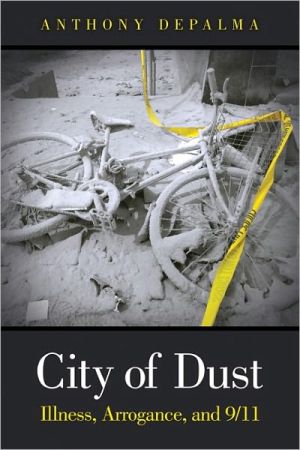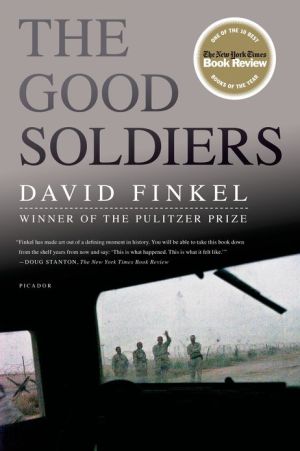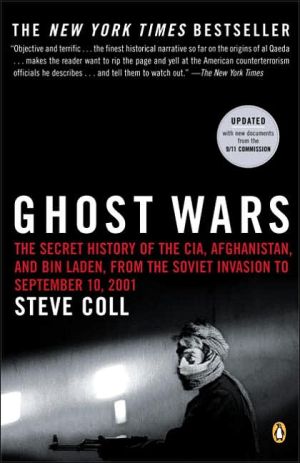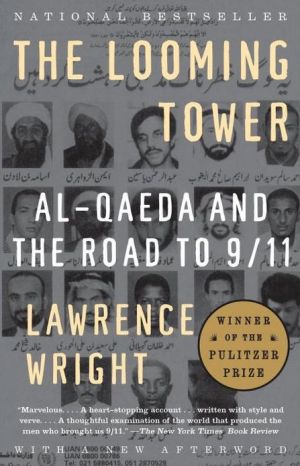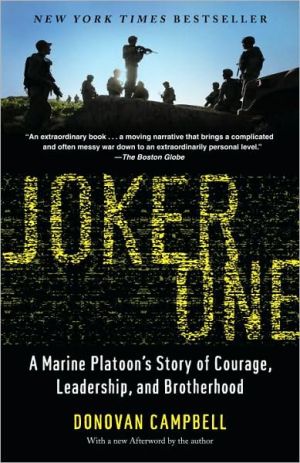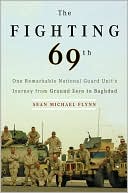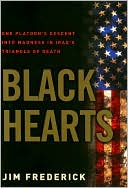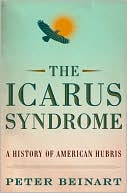City of Dust: Illness, Arrogance, and 9/11
"Part chronicle of tragedy and heroism, part detective story, and part legal thriller, this book offers a comprehensive and fearless account of the environmental aftermath of the September 11th attack on the World Trade Center and the public health consequences of the worst environmental disaster in New York City’s history.”\ Eric A. Goldstein, New York City Environment Director for the Natural Resources Defense Council\ "City of Dust delivers what is so often missing from 9/11...
Search in google:
The World Trade Center’s destruction unleashed one of the gravest environmental catastrophes in U.S. history. Now, former NY Times Ground Zero reporter Anthony DePalma presents a full accounting of the disaster that followed 9/11. He separates myths from reality…reveals decisions that destroyed public trust…shares victims’ untold stories…and helps us ensure this never happens again.
IntroductionIntroduction\ Of all the images of the September 11, 2001, attack on New York, the one that’s been hardest for me to shake is not the fiery flash of impact, or the harrowing sight of desperate people leaping to their deaths, or the awesome 10.52 seconds it took for the first tower to buckle and cave in on itself in a maelstrom of concrete and ash, followed incredibly by the second tower falling just as fast, a few yards away. Terrible indeed were those images, but there was also an aspect of cinematic unreality about them that has kept me distant, as though watching a movie or playing a video game. The one picture that has left an indelible scar on my heart is an unlikely photograph that my colleague Eddie Keating took of an elegant tea set he came upon in a vacated apartment near ground zero. The matching teapots, cups, and sugar bowl, perhaps set for breakfast on that achingly clear September morning, were covered with a skintight layer of dust the color of dried bones.\ That ghostly tableau has stuck with me in the years since I first saw it, not because it elicits horror or dredges up anger, but because it so strikingly symbolizes the way the event and its aftermath have clung to so many people far beyond the grim arenas of terrorism, war, and the doomed World Trade Center itself. The fancy china had no direct connection to the events of that day before the first plane struck. And yet it had been enveloped in a supple coating of death and destruction that transformed it from a treasured implement of daily life to an artifact of a moment of death. The dust infiltrated thousands of offices and apartments in the same way. It was carried back to thousands more homes by first responders, construction workers, and volunteers who helped in the days and weeks after the attack—at first to find survivors, then sadly to recover the remains of victims and clean up the site to show the terrorists, and the world, that the great city had been hurt but not humbled. It turned New York into a city of dust.\ That dust has clung to the city just as surely as it coated the tea set, transforming New York. What happened after the attack is a uniquely American tragedy, triggered by the same virtues of generosity and care that have come to be most associated with the American character. It took only seven days for Wall Street to limp back to business, showing the terrorists that their violence had not undone America. That was the essential message. There was no time for the great city to dwell on what the long-term impact of the dust might be, or even to acknowledge that there could be a lingering danger. The failure to reopen Wall Street quickly would have been a certain disaster. A distant threat that the dust might have poisoned the air and made part of the city unlivable was then not only uncertain, it was unacceptable.\ So the ground was set for a tug-of-war between truth and exaggeration, between alarmism and deception, between personal safety and political expediency that turned the worst environmental disaster in New York City history into a test of our science, our laws, our precepts of governance, and even our traditional understanding of the common good. In essence, it became a test of ourselves. Although the attack exposed mortal flaws in the nation’s ability to protect itself from terrorists who hoped to die in the attack, reopening Wall Street proved that America had not been defeated. But the very success of that effort, and the quick work that was made of the cleanup and recovery that followed, was laced with tragedy. In ways that would become apparent only over time, our handling of the aftermath of the attack revealed that this nation was not prepared to protect itself from itself.\ The problems that arose after 9/11 have been presented as a deliberate attempt by the Bush administration, as well as the city, to cover up the danger, a vast conspiracy to put profit ahead of people’s health. But it wasn’t that. Many bad decisions clearly were made, but there was no venality, nor was there a conspiracy to hide the enormity of what happened, if that were even possible. Rather, a long sequence of individual decisions—some made in haste, some made with arrogance—favored the recovery of the city over the recovery of its people.\ In response to this catastrophe, the men and women of science and medicine tried against enormous odds to piece together a compassionate response and to provide answers for those who desperately needed to know what had happened to them and what they could expect in the future. The word hero was thrown around freely, at times used when and where it was not warranted. There were genuine heroes and villains, but they did not confront each other in the direct way this conflict was portrayed once the tabloid press hijacked the disaster. Mayor Rudy Giuliani wasn’t the only one who made difficult choices that seemed to put recovery ahead of precaution. Even those who were most experienced at rescue made decisions that ultimately would have tragic consequences. The heroic firefighters who searched for their fallen brethren believed that exposing themselves to hazardous material in order to recover their dead was a justified calculation. In their eyes, the living owed a debt to the dead that made self-interest intolerable.\ The defining characteristic of the catastrophe is that from the morning of September 11, the dangers presented by the dust and ash were clear for everyone to see. Billowing gray dust plumes rampaged through city streets like monsters unleashed from hell. Microscopic dust was transformed into a gruesome invader, attacking the most essential of human needs—the need to breathe. It was inescapable, yet the dust became a metaphor for the blindness that descended on the city, obscuring reality and confounding decisions that would later be regretted.\ Although millions of people watched in horror as the buildings disintegrated, the dust itself remained a mystery. Even with the most advanced science, we do not yet know what the wicked concoction of dust, ash, and toxic materials did when it landed deep inside the heaving lungs of responders. We don’t know how it short-circuited their immune systems or toyed with their genes. And we won’t know for years if it combined with other poisons to speed up or exacerbate carcinogenic attacks on the bodies of people who were coated with it, just as the tea set was coated. However, we do know that the doubts sown in the very earliest days have been long lasting. What might have been a sentinel case of emergency response that raised an entire nation from its knees instead became an endless cycle of bickering, mistrust, sickness, and uncertainty as officials tried to deflect blame, responders became crusaders for themselves, lawyers sought to make courtroom history, and emotions that had never before been felt rose to the surface. A wounded city became a diseased city that often refused to recognize its own disabilities.\ Now, long after most of the dust itself has been cleared away, many individual stories of true courage and heroism burn through this haze of doubt. There has been no end to the searing accounts of men and women who truly acted like heroes only to be laid low by diseases they cannot explain. There have been stirring examples of men and women of science who have refused to allow politics or public opinion to shade their work, and who have toiled against great odds and in the most challenging of circumstances to continue to provide care in the screening and treatment their patients needed. Heroes have abounded.\ Unfortunately, the combination of our darkest traits and our most noble ones made the story of the city of dust more compelling than the truth could justify, and some have succumbed to the temptation to bend the truth to serve their needs. It will take years for the air to clear, if it ever does.\ Certainty, in principle and in practice, itself became a victim. The doubters initially used principles of certitude to challenge the notion that the dust made people sick. By denying any danger in the early weeks and months after 9/11, New York City and Washington hesitated to take steps that could have reliably assessed the safety of workers and residents. By not being clear about the risks, the federal and municipal governments—in what has been called a conspiracy of purpose—sacrificed a degree of safety for the quick recovery of Wall Street. Then, by staking out a high moral ground that made it difficult to question survivors’ symptoms, advocates made it easier for abuses to take place.\ For four years, I covered the environmental and health consequences of ground zero for The New York Times. Many of my articles appeared on the front page of The Times and were reprinted around the world. I got to know many of the most important people involved, from the earliest attempts to identify the contents of the dust, up to the historic mass litigation that brought thousands of responders to court charging New York City with negligence. At every turn, I encountered people on both extremes of the issue—those who refused to believe that the dust had caused anyone to become sick, and those who refused to accept that the dust was not going to kill everyone it touched. When the head of the federal Environmental Protection Agency said the air was safe to breathe, I, like so many New Yorkers, was relieved because, at that time, in the days just after the attacks, it seemed impossible to have processed more bad news. I believed because I wanted to believe. Later, as I investigated what had happened, I came to view things differently.\ The city of New York at one point estimated that more than 500,000 people may have been affected by the dust in some way.1 In addition, thousands of people from across the country came to New York at that tragic time to work on the pile. Millions watched the towers fall and sympathized with those who were injured while doing their jobs. Under most circumstances, American society celebrates the efforts of those who respond to emergencies. In New York, some of those people have been all but forgotten. The painfully slow physical rebuilding of ground zero receives far more attention than does the health of those who responded to the disaster. Even as the ranks of the sick grow, they fade farther into the background. And not just the responders were touched by the dust. Residents, workers, scientists, doctors, lawyers, and politicians all felt the dust in some way. This story of the victims of the aftermath of 9/11, told through the personal experiences of the individuals whose lives have never been the same since that day, represents an overlooked chapter of one of the most extraordinary events of our time.\ The scientific, medical, political, and legal scope of the disaster has never been looked at in this comprehensive way. Because of the massive litigation against the city, many of the individuals most intimately involved in the cleanup and its aftermath have declined to speak out publicly, leaving their court testimony to speak for them. Everything about the disaster is monumental, except for the dust itself. But only when the small decisions and the individual acts of arrogance, ignorance, and courage are examined will a telling sense of the tragedy come through. In the end, it is a story of fear and a story of hope. The people of the city, like the city itself, were laid low but were not broken. And we, as a society, will not be prepared to handle the next disaster unless we fully understand what we did right—and wrong—the last time.\ Endnotes\ 1 “Assessing the Health Impacts of 9-11,” Report of the World Trade Center Health Panel, February 13, 2007: 50.\ © Copyright Pearson Education. All rights reserved.
AcknowledgmentsAbout the AuthorPart I: CatastropheIntroduction 3Chapter 1 All That We Hold Dear 9Chapter 2 Optimism or Arrogance? 27Chapter 3 Significant Chaos 43Part II: DiseaseChapter 4 Raising Doubts 65Chapter 5 A Gathering Storm 81Chapter 6 Building a Science 99Chapter 7 It's Not the Dying 117Chapter 8 Life and Dust 145Part III: DoubtChapter 9 Such Money Grubbers as These 171Chapter 10 Degrees of Certitude 191Chapter 11 Beyond Doubt 209Chapter 12 Assaulting Uncertainty 239Chapter 13 Science on Trial 261Part IV: RealityChapter 14 Missed Opportunities 287Chapter 15 Afterclap 299Epilogue 317Index 329
